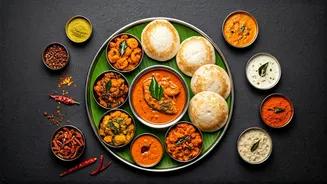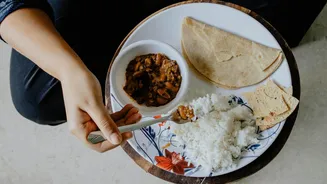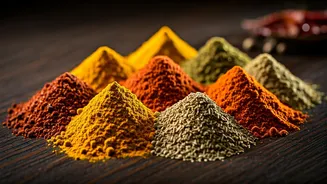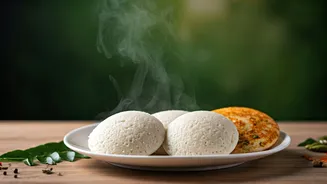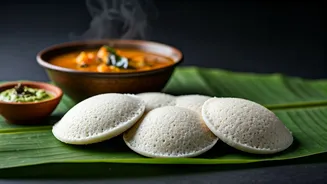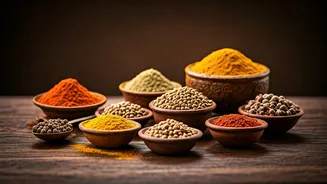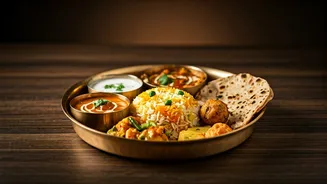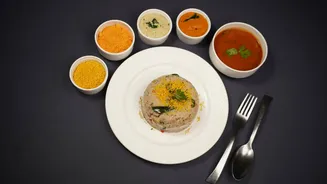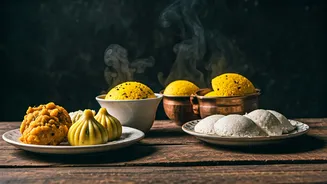A Land of Spices
Kerala, often called the 'Spice Coast of India,' owes its distinctive flavors to its rich history of spice trade. From ancient times, the region attracted
traders from around the globe, who brought with them new ingredients and culinary traditions. This exchange of flavors resulted in a cuisine that's characterized by the liberal use of aromatic spices. These spices, including cardamom, cloves, cinnamon, and pepper, are used to infuse dishes with depth and complexity. Spices are carefully blended to create unique flavor profiles. The use of spices is not just about enhancing taste; it's a fundamental part of the culture. These spices are not only added to dishes, but are also an integral part of the daily life of Keralites. The fragrant spices are used to create the vibrant and unforgettable taste that Kerala is known for.
Coconut's Central Role
Coconut is a cornerstone of Kerala's cuisine, featured in countless dishes in multiple forms. From the fresh coconut milk used in curries to the grated coconut that adds texture and flavor, this ingredient is indispensable. Coconut oil is the preferred cooking medium, imparting a unique aroma and taste to the food. You can find it in everything from savory dishes to sweet desserts. Coconut water is a refreshing drink and coconut flesh is also used. The versatility of coconut in Kerala cuisine is a testament to its abundance in the region. The fruit's importance showcases how the locals have skillfully integrated the coconut into their cooking, making it an essential part of Kerala's culinary identity.
Seafood Specialities
Due to its long coastline, Kerala is celebrated for its delectable seafood dishes. Fresh catches from the Arabian Sea, including fish, prawns, crabs, and mussels, are prepared using unique local techniques and spices. The 'Meen Molee,' a fish stew in coconut milk, and the 'Prawn Curry' cooked with tamarind and spices are just two popular examples of the delicious food. The use of fresh ingredients and traditional methods ensures that the flavors are authentic and the seafood is cooked to perfection. Seafood plays a large role in Kerala cuisine, and is a staple in the state's diet. Seafood is cooked in various styles, from grilled to fried to curried, each dish offering a different flavor profile. The seafood dishes in Kerala offer a culinary adventure for every palate.
Vegetarian Delights
While seafood is a highlight of Kerala's cuisine, the state also offers a wide range of vegetarian dishes. These dishes are as vibrant and flavorful as the non-vegetarian options. 'Sambar,' a lentil-based vegetable stew, is a staple, alongside 'Avial,' a mixed vegetable dish cooked with coconut and yogurt. The use of fresh vegetables, aromatic spices, and coconut milk creates dishes that are rich in flavors. Vegetarian meals in Kerala typically include a combination of rice, curries, and side dishes. These vegetarian dishes, made with fresh, locally-sourced ingredients, reflect the diversity of Kerala’s culinary heritage. The use of traditional cooking methods ensures that these dishes are flavorful and cater to a range of palates.
Rice and Sides
Rice is the primary carbohydrate source in Kerala, served with almost every meal. It comes in various forms, including the red rice, known for its distinct flavor and health benefits. A typical Kerala meal often comprises rice alongside different curries, such as those made with vegetables, lentils, and meat or seafood. Side dishes like 'Papadams' (crispy lentil crackers) and 'Pickles' are also very important in a complete meal. These side dishes add texture and additional flavors, enhancing the overall dining experience. The way that rice and side dishes are put together illustrates the balance of flavors and textures in Kerala’s cuisine. It shows how food is not only about satiating hunger, but also about providing a rich sensory experience.
Breakfast Traditions
Kerala's breakfast traditions are diverse, with popular dishes that set the tone for the day. 'Idli' (steamed rice cakes) and 'Dosa' (fermented rice pancakes) are common, served with 'Sambar' and coconut chutney. 'Puttu,' a steamed rice cake often paired with 'Kadala Curry' (black chickpea curry) is a beloved breakfast dish. These breakfasts are not only tasty, but also nutritious, providing a good start to the day. The variety of breakfast options indicates the cultural diversity of Kerala. Each dish is prepared with unique techniques and ingredients, offering a special taste. These breakfast meals show the dedication of Keralites to start their day with flavor and energy.
Sweet Endings
Desserts in Kerala provide a sweet finale to any meal, often featuring coconut, jaggery, and rice. 'Payasam,' a sweet pudding made with milk, rice or vermicelli, and sugar, is a traditional dessert that's often served during festivals and special events. 'Unni Appam,' a sweet fritter made with rice flour and jaggery, is also popular. These desserts are made with locally-sourced ingredients, reflecting the state's agricultural wealth. The combination of sweetness with the flavors makes the perfect ending to a meal. These desserts show the local appreciation for simple yet delicious food. It is also an integral part of Kerala's culinary identity, bringing people together in celebration.
Influences and Evolution
Kerala's cuisine has been shaped by the influence of many cultures over the centuries. Portuguese, Dutch, and British traders left their marks on local food practices. The cross-cultural contact introduced new ingredients and cooking methods that have influenced Kerala's culinary landscape. This influence is clear in the use of certain spices, the preparation of certain dishes and cooking techniques. Today, Kerala's cuisine has also been updated with modern innovations. This includes efforts to adapt and modernize traditional dishes. The ability to embrace new ideas, whilst preserving its heritage, is what makes Kerala's cuisine special. This continual evolution ensures that Kerala’s food remains fresh, exciting, and an important part of its heritage.
